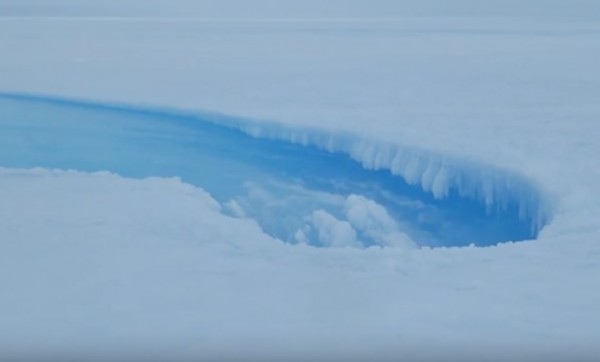By Ana Verayo, | December 13, 2016

Meltwater stream inside the crater on the Roi Baudouin ice shelf. (YouTube)
Scientists have spotted a mysterious, two-kilometer wide crater on the Antarctic ice shelf. They initially thought that it was caused by a large meteorite impact. However, in a new study, climate scientists have identified the culprit behind this hole, linking it to powerful winds in the region.
Like Us on Facebook
In January 2016, scientists from Belgium and the Netherlands investigated this crater and measured it to be three meters deep with raised edges and three moulins, which are ice shafts shaped like wells that created two meltwater streams.
This suggests that this crater is also a meltwater lake but drains during seasons, as water drains within the Antarctic ice shelf. Scientists say that strong winds that travel downslope from the ice sheet's interior apparently shaped this crater formation.
These winds often originate from a single direction and blow over the entire Antarctic ice sheet at 35 kilometers per hour, causing weathering. This, in turn, erodes the ice shelf and exposes the blue ice underneath.
When this blue ice is exposed, it absorbs much sunlight as winds also increase the surface temperature of the ice sheet. When winds are especially strong, the ice shelf melts more than usual, and the mixing of these winds and ice shelf temperatures brings about the warmer air that causes this ice to melt.
Researchers discovered that there were multiple lakes under the crater, about seven meters below the surface of the ice shelf. This suggests that surface melting caused these new lakes to form under the Antarctic ice sheet.
More specifically, as this large crater lake drained meltwater, it collapsed and formed more lakes underneath. According to the author of the study, Jan Lenaerts of Utrecht University and KU Leuven, in the Netherlands, this buildup of pressure on the lake causes it to drain or collapse under the surface.
Lenaerts added that this is not a meteor site but a remnant of the ice shelf's surface or subsurface, where this disappearing lake eroded from strong winds.
This new study was published in the journal Nature Climate Change.
-
Use of Coronavirus Pandemic Drones Raises Privacy Concerns: Drones Spread Fear, Local Officials Say

-
Coronavirus Hampers The Delivery Of Lockheed Martin F-35 Stealth Fighters For 2020

-
Instagram Speeds Up Plans to Add Account Memorialization Feature Due to COVID-19 Deaths

-
NASA: Perseverance Plans to Bring 'Mars Rock' to Earth in 2031

-
600 Dead And 3,000 In The Hospital as Iranians Believed Drinking High-Concentrations of Alcohol Can Cure The Coronavirus

-
600 Dead And 3,000 In The Hospital as Iranians Believed Drinking High-Concentrations of Alcohol Can Cure The Coronavirus

-
COVID-19: Doctors, Nurses Use Virtual Reality to Learn New Skills in Treating Coronavirus Patients







